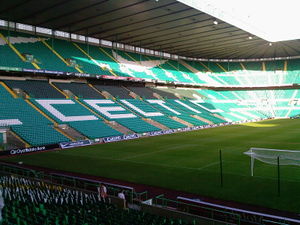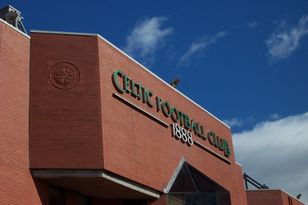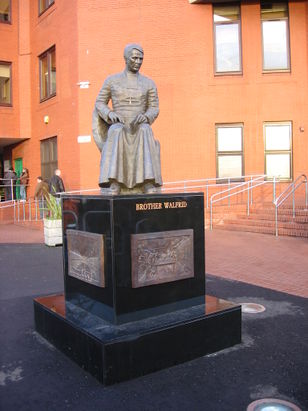Celtic Park
| Celtic Park | |
|---|---|
 |
|
| Location | |
| Opened | 1892 (most recently renovated 1998) |
| Owner | Celtic Football Club |
| Surface | Grass (1892–present) |
| Capacity | 60,832 (Football) |
| Tenants | |
| Celtic Football Club (Scottish Premier League) |
|


Celtic Park is a football stadium in the Parkhead area of Glasgow in Scotland. It is the home ground of Celtic Football Club. The all-seater stadium is also known as Parkhead and occasionally nicknamed Paradise by Celtic fans.
It is the second largest stadium in Scotland by capacity, after Murrayfield Stadium in Edinburgh, and the sixth-largest in the United Kingdom after Murrayfield, Old Trafford, Twickenham, Wembley and the Millennium Stadium.
Contents |
History
The original Celtic Park was built by a large band of volunteers in 1888. Its opening game was against Rangers on 28 May 1888, which Celtic won 5–2. Within 3 years Celtic decided to build a new stadium after annual rental costs rose from £50 to £450. The new stadium was built in a disused brickyard just across the street from the old stadium in 1892. A journalist covering the event reported that it was like "moving from the graveyard to paradise" hence the nickname "Paradise".[1] The main stand was designed by Archibald Leitch, the architect who designed over 20 stadiums throughout Britain. Celtic Park hosted the first ever Composite rules Shinty/Hurling match held in Scotland in 1897.[1]
In 1938 Celtic Park saw its largest attendance of 92,975 when Celtic played a First Division match against Rangers.[2] While Hampden Park was being redeveloped during the 1990s, Celtic Park hosted a number of cup finals, the most recent being the 1998 Scottish League Cup Final. Celtic Park has also hosted a number of Scotland internationals, primarily when Hampden Park has been unavailable. This happened most recently in 2006 when Hampden had been booked for a Robbie Williams concert in advance of the UEFA Euro 2008 qualification fixtures being determined, meaning that Scotland's match against the Faroe Islands had to be played elsewhere.[3]
The stadium has undergone numerous redevelopments; in 1988, Celtic's centenary year, the red-bricked exterior to the main stand was added and in the mid-1990s further development was undertaken to make the stadium comply with the Taylor report. In the summer of 1994, the Jungle (North enclosure), East Terracing and West Terracing were demolished. The stadium reopened in the summer of 1995 with the new 27,000-seat North Stand and the existing Main Stand in place. The redevelopment was completed for the beginning of the 1998/99 season.
Future
Celtic have investigated the possibility of increasing the capacity of Celtic Park. Chief executive Peter Lawwell said in April 2007 that the site of the Main Stand could be redeveloped to increase the capacity by 8,000, but it was considered too expensive.[4]
Celtic Park will host the opening ceremony of the 2014 Commonwealth Games.[5]
References
- ↑ FIFA.com - Celtic spirit shines on
- ↑ Inglis, Simon: Football Grounds of Britain, page 432. ISBN 0-00-218426-5
- ↑ Gig Robs SFA of Hampden clash, Edinburgh Evening News, 10 March 2006.
- ↑ Evening Times article 30/04/07 (Last 3 Paragraphs)
- ↑ The Official website of the Glasgow 2014 Commonwealth Games / Village and Venues / Celtic Park
External links
- Description and Gallery
- Satellite map
- Explore Glasgow - All round the city Modern drawings of the old and the new stands at Celtic Park
- Celtic Park at the Scottish Football Archive
- Virtual Celtic Park Stadium Tour
|
||||||||||||||
|
|||||
|
||||||||||||||||||||||||||